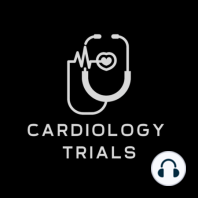8 min listen
Review of the PROVE IT-TIMI 22 Trial
ratings:
Length:
10 minutes
Released:
Feb 29, 2024
Format:
Podcast episode
Description
NEJM 2004;350:1495-504.Background The benefit of cholesterol lowering with statins compared to placebo had been demonstrated in multiple trials across a range of cholesterol starting levels in patients with and without a history of coronary artery disease. The average reduction in cholesterol from baseline levels in these trials was in the range of 25% to 35%. Guidelines at the time this trial was undertaken recommended an LDL treatment target of <100 mg/dl. The Pravastatin or Atorvastatin Evaluation and Infection Therapy-Thrombolysis in Myocardial Infarction 22 (PROVE IT-TIMI 22) trial sought to test the hypothesis that more intensive LDL lowering with atorvastatin 80 mg daily would reduce a composite endpoint of cardiovascular events compared to less intensive LDL lowering with pravastatin 40 mg daily in patients hospitalized with ACS.Cardiology Trial’s Substack is a reader-supported publication. To receive new posts and support our work, consider becoming a free or paid subscriber.Patients Patients had to be ≥18 years of age and hospitalized for either AMI or high-risk unstable angina in the preceding 10 days. They had to be in stable condition and were to be enrolled after a PCI, if one was planned. Finally, they had to have a total cholesterol level ≤240 mg/dl. For patients already on long term lipid lowering therapy they had to have a total cholesterol level of ≤200 mg/dl. Exclusion criteria including coexisting conditions that shortened expected survival to less than 2 years, were receiving any statin at a dose of 80 mg daily at the time of index event, had undergone PCI within the previous 6 months or CABG within the previous months or were scheduled to undergo CABG in response to the index event, had serious hepatic illness or had a creatinine level >2 mg/dl.Baseline characteristics The average age of patients was 58 years and 78% were men; 90% were white. The index event was unstable angina in 30%, NSTEMI in 36% and STEMI in 34%. Seventy percent of patients underwent PCI for the treatment of their index event. Less than 20% of patients had a prior MI, 18% had diabetes and 50% had hypertension. The median total cholesterol was 180 mg/dl, LDL was 106 mg/dl, HDL was 39 mg/dl and triglycerides were 150 mg/dl.Procedures Eligible patients were randomly assigned to receive either atorvastatin 80 mg or pravastatin 40 mg daily in a double-blind fashion. Patients were seen for follow-up visits and received dietary counseling at 30 days, at 4 months and every 4 months thereafter until their final study visit in August or September 2003. Blood samples were obtained at randomization, at 30 days, at 4, 8, 12, and 16 months and at the final study visit for measurement of lipids and other components that were part of the safety assessment. Measurements were made at core laboratories. The dose of either study drug could be cut in half if liver enzymes or creatinine kinase was elevated (levels not specified) or in the presence of myalgias (criteria not defined).Endpoints The primary endpoint was the time from randomization to the first occurrence of a component of the primary composite endpoint, which included: all-cause death, nonfatal MI, documented unstable angina requiring hospitalization, revascularization with PCI or CABG if either were performed 30 days after index event, and stroke. Secondary endpoints were occurrence of each component of the primary composite endpoint as well as a composite of death from coronary heart disease, nonfatal MI or revascularization occurring at least 30 days after index event and another composite consisting of death from coronary heart disease and nonfatal MI.The study was designed to test whether pravastatin 40 was non-inferior to atorvastatin 80 with respect to the event rate for the primary composite endpoint at 2 years. To claim non-inferiority for pravastatin, the one-sided 95% confidence interval for the relative risk of the 2-year event rate in the pravastatin group could not exceed 1.17,
Released:
Feb 29, 2024
Format:
Podcast episode
Titles in the series (40)
Review of the GISSI-1 Trial by Cardiology Trials
